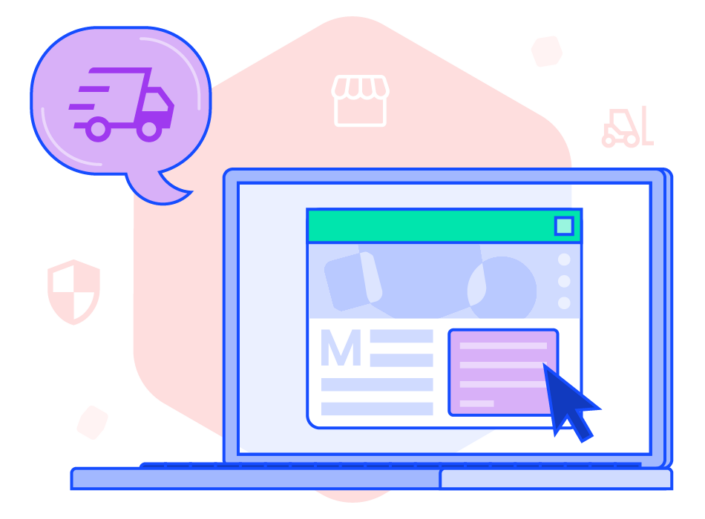As an organization grows, its shipping process evolves. But whether you’re just starting your business or already managing a large team of logistics professionals, you have many of the same questions and concerns.
How can I ship as quickly and affordably as possible? What parts of my shipping process can I automate? Will the supply chain investments I make pay off?
To answer these questions, you need to take a close look at every step in the shipping process. In this article, we’ll explain how the shipping process works, who’s involved, and what you can do to optimize it.
What is the shipping process?
The shipping process encompasses all the steps involved in moving goods from your business to end consumers. It includes order processing, picking and packing, carrier selection, last-mile delivery, reverse logistics, and even customer service.
Regardless of size, every ecommerce business needs to master shipping if they want to survive in a competitive market. By optimizing each step of the process, you’ll enhance efficiency, reduce costs, and improve the customer experience.
The main steps of the shipping process
Since the birth of ecommerce in the late 1990s, organizations have refined and drastically improved their shipping performance. Today, most businesses are keeping customers happy: In one survey, 77% of online shoppers rated their deliveries over the past six months at least an eight out of 10. Still, you can always improve!
When you understand everything that goes into the shipping process, you’ll be better able to make tweaks and adjustments that will push your customer satisfaction to 10 out of 10.
We’ve broken the shipping process into 3 main phases: pre-shipping, shipping, and post-shipping.
Pre-shipping
Before shipping anything, you need to have inventory available to meet customer demand. If a product is marked out of stock on your website, you could lose sales; 59% of consumers say that products being in stock and ready to ship influences their decision to shop from a retailer.
Optimization tip: Track stock levels with an inventory management system. For full inventory visibility, an inventory management system is an essential part of your logistics tech stack.
As customers make purchases on your ecommerce platform, you’ll receive their order information in your order management system (OMS). These systems should be able to send and receive data in real time—if that doesn’t happen, you’ll face a ripple effect of delays that impact every element of your shipping process.
Optimization tip: Make sure every system is seamlessly integrated. Your ecommerce platform, order management system (OMS), warehouse management system, inventory management system, shipping software, and other logistics technology should be able to pass data back and forth automatically. With full integration, the shipping process will run smoothly from start to finish.
Shipping
This stage of the shipping process has the largest impact on the overall delivery experience, so it’s important to get it right. We’ll break it down into six smaller steps.
Step 1: Gather information and documentation
As you know, shipping isn’t just about putting products into boxes. It all starts with collecting essential information. If you’re shipping internationally, you’ll need to fill out the appropriate customs forms, and regardless of your customers’ locations, you’ll need at least one crucial piece of information: their address.
Optimization tip: Verify addresses automatically to avoid errors. Incorrect addresses can cause packages to get stuck in shipping limbo. To keep things on track, verify customer addresses for accuracy using address verification software, which automatically detects errors and typos when shoppers enter their addresses online.
Step 2: Pick the product(s)
If your warehouse is organized with efficiency in mind, the picking process should be a breeze! As workers apply systematic approaches like zone or wave picking, they’ll be able to gather items for orders quickly, with minimal walking time. To take things a step further, turn to technology.
Optimization tip: Automate your warehouses. In addition to using efficient picking strategies, consider automating your warehouses with software, robotics, and machinery. Relying on your warehouse management system (WMS) or pick and pack software to show you the most efficient picking and packing methods is an excellent start. Eventually, adding things like automated guided vehicles (AGVs), conveyor systems, and robotic arms will revolutionize your picking, packing, and sorting.
Kim Baudry, market development director at Dematic, explains that automating your warehouse has long-term benefits that shouldn’t be overlooked. “When you use automation, especially when you can store products in smaller spaces—and pick and pack in smaller spaces—you can actually shrink the size of a distribution center significantly.”
The result? Money saved on labor, electricity, and warehouse space—not to mention more sustainable operations.
Step 3: Pack the products(s)
Packing is most effective if you have standard processes in place for choosing packaging sizes, adding filler material, adding appropriate labels (like “Fragile”), and securely packing boxes.
Optimization tip: Minimize waste. Packaging can get costly, driving up total shipping costs. Reviewing your packaging materials and processes can help you save money. Choose packaging that fits your products snugly to avoid unnecessary dimensional weight charges, and consider lightweight (but durable) packaging options.
In addition to saving money and preventing package damage, more efficient packaging has a positive environmental impact. When your business incorporates sustainable practices, it’s more appealing to eco-conscious customers, many of whom look for sustainable delivery options.
Step 4: Choose your carrier and shipping method
Even experienced shippers struggle to choose the right carriers and shipping methods. As you evaluate carriers, examine factors like shipping rates, delivery speed, and reliability. Keep in mind that large carriers are often known for their speed and reliability, while smaller ones offer cost-effective ways to ship to specific areas.
Once you’ve chosen a carrier, you need to choose a shipping service. The most effective shipping method will depend on package size and weight, destination, and desired delivery speed. If you’re shipping a restricted item, such as alcohol, that will factor into the service you use as well.
Just make sure to tailor your shipping methods to meet customer expectations. Offer choices like standard, expedited, and express shipping, keeping in mind that 29% of consumers have abandoned an order because it wouldn’t arrive by the time they needed it.
Optimization tip: Streamline multi-carrier shipping with technology. Shipping software like EasyPost Enterprise simplifies this step of the shipping process by automatically integrating with an extensive carrier library, generating the best carrier options and shipping methods based on delivery specifications, and automatically creating shipping labels.
Step 5: Hand packages over to the carrier
Once you’ve meticulously picked and packed products, the final step is handing packages over to your carrier(s) of choice. You can ensure a smooth transition by coordinating with your carrier’s logistics team to schedule pickups or drop-offs. For best results, clearly communicate shipping details, including package weight, dimensions, and any specific handling instructions.
Step 6: Provide customers with tracking information and estimated delivery times
Your role in the shipping process doesn’t end once you’ve passed packages to carriers. To help customers monitor the status and location of their shipments, use a robust tracking system and clearly communicate estimated delivery windows.
Rather than sending customers to a carrier’s tracking platform, consider creating a custom tracking portal to give your customers a more cohesive experience with your brand.
Optimization tip: Use tracking data to improve shipping performance. Accurate package tracking will reduce customer questions and concerns, but it will also give your logistics and customer service teams the information they need to address issues that arise. If you notice common problems with specific carriers (like frequent package damage), you’ll have hard evidence when it comes time to address the issue.
Post-shipping
Once parcels are on the road, your focus shifts to resolving potential problems. Several things could go wrong, and you need to be prepared for all of them:
- Return requests
- Package damage
- Lost orders
- Porch piracy (package theft)
- Other customer complaints
When customers bring problems to your attention, address their concerns. By resolving shipping issues promptly, you’ll bolster trust, minimize disruptions, and give customers the confidence to buy from you again.
Optimization tip: Make returns a breeze. Include prepaid return labels with every order to boost customer satisfaction. You can either print and pack labels with original shipments or provide a QR code via email.
Who participates in the shipping process?
The shipping process involves three main participants: the shipper, carriers, and outsourced logistics companies (3PL or 4PL). As each of these participants coordinate and work together, the shipping process will run smoothly.
Let’s review what you can do to build solid relationships with other organizations that are involved in your shipping process.
Shippers
The shipper is the entity that processes orders and prepares them for shipping. Unless you use a 3PL, you’re the shipper! As a shipper, you make many crucial decisions: choosing carriers, negotiating rates, and implementing strategies to make sure the shipping journey aligns with customer expectations. Your most important goal? Keep customers happy by offering affordable shipping costs and flexible delivery options.
Your in-house logistics team is the single most important driver of improvements to the shipping process—regardless of how your other partners perform. Depending on the fulfillment channels you use, you’ll need to adjust your shipping strategy.
Fulfilling orders from a brick-and-mortar store
If you use an omnichannel fulfillment strategy, your brick-and-mortar locations aren’t just where customers come to shop in-person. They also act as miniature distribution centers, where online orders are picked, packed, shipped, and returned.
In order for goods and information to flow smoothly across all your sales channels, all your technology must be integrated. Inventory visibility is especially essential, as it ensures that you have enough stock to fulfill online orders and meet the demand of in-person shoppers.
Optimization tip: Bring in omnichannel fulfillment experts. Supply chain consultants can jumpstart (or improve) your omnichannel operations. Work with an organization like Summit Advisory Team to access several decades worth of expertise in omnichannel logistics.
Fulfilling orders from a warehouse or distribution center
As a shipper, your warehouses and distribution centers are some of your most valuable assets. When these facilities are well-organized, with modern technology in place, you’ll see shipping efficiency and accuracy skyrocket.
Optimization tip: Invest in scalable infrastructure. Design your distribution center infrastructure to be scalable so it can accommodate growth and seasonal fluctuations in demand. This might involve investing in flexible storage solutions and adaptable technologies that can handle large order volumes.
Carriers
Carriers like USPS, UPS, and FedEx are responsible for physically transporting packages from the point of origin to the end destination. As an ecommerce business, your choice of carriers influences shipping costs, delivery speed, and the reliability of the overall logistics operation. Collaborating effectively with carriers ensures a smooth shipping experience for your customers.
When packages are in the hands of carriers, you don’t have much control over what happens to them. So it’s your responsibility to proactively communicate with carriers to ensure high-quality delivery. As you vet and begin working with new carriers, research their reliability. If your shipping data shows recurring issues (like frequent lost, damaged, or delayed shipments) reach out immediately to discuss solutions.
Every carrier comes with a cost. In addition to paying base shipping rates, you’ll need to pay additional fees for oversized packages, residential delivery, peak season shipping, and more.
With so many factors to consider, your best bet for finding the most affordable carrier services is using shipping software. Shipping platforms let you integrate with new carriers quickly and optimize for the best ways to send packages. You’ll save money by automating the shipping process and accessing special discounted rates (including getting to keep any discounts you’ve already locked in with individual carriers).
3PLs or 4PLs
Rather than handling logistics internally, some businesses outsource to a 3PL or 4PL. This comes with pros and cons: While it simplifies shipping, it also decreases your direct control over the delivery experience. If you do decide to outsource, your 3PL(s) and/or 4PL will play an important role in sending packages quickly and accurately.
Third-party logistics providers, or 3PLs, handle the hands-on tasks of order fulfillment. They store your inventory in their distribution centers, then pick, pack, and ship orders.
Fourth-party logistics providers, or 4PLs, strategically oversee every element of your supply chain. This often includes managing relationships with one or more 3PLs. The 4PL acts as an intermediary between you and your 3PLs to simplify communication.
While 3PLs definitely help streamline order fulfillment, they don’t have the scope or resources to craft an end-to-end supply chain strategy—for that, you’ll need a 4PL. Whichever one you go with, it’s essential to thoroughly understand their costs, processes, and tech stack before signing a contract.
Optimization tip: Set clear expectations. Before deciding to work with a 3PL or 4PL, do your research. Learn their capabilities, including infrastructure, technology, experience, and expertise in your industry. The logistics provider should be able to meet not only your current requirements, but future ones as your organization scales. Regularly review key performance indicators (KPIs) to see whether the logistics provider is meeting agreed-upon standards.
Leveraging technology to optimize your shipping process
Even little inefficiencies in your shipping process can lead to delayed or inaccurate orders. This wastes money and increases the risk of losing customers or getting negative online reviews. So, which tech can help you increase efficiency and optimize your shipping process? We recommend prioritizing the following systems.
Enterprise shipping software
Shipping costs have a big impact on your profits, and they also play a role in determining whether online shoppers purchase from you. When consumers are choosing what stores to do business with, free shipping is the number one concern for 80% of them, and 38% at least want to see “reasonable fees.”
Many organizations lock in shipping rates with carriers, regularly negotiating contracts. This can be beneficial during a shipper’s market, when low demand for parcel shipping causes carriers to lower prices. However, negotiating rates with carriers isn’t always the right move.
An alternative to working with just a few carriers and negotiating contracts is to use shipping software instead. These platforms integrate with large, local, and regional carriers, allowing you to ship with whichever ones work best in different scenarios. They also provide access to competitive discounted rates and present the most cost-effective methods of shipping each package.
If you use EasyPost Enterprise, you’ll get the best of both worlds: In addition to accessing our discounted rates, you’ll be able to keep any rates you’ve already negotiated.
Inventory management system and WMS
Good shipping starts with your warehouses. The faster orders are picked and packed, the faster you’ll be able to get orders out to customers. An inventory management system and WMS will work together to keep your facilities running smoothly.
Inventory management systems track inventory across all locations, letting you know when it’s time to replenish stock to meet customer demand. They help with supply chain management, demand forecasting, restocking, and storage.
Your WMS goes hand-in-hand with your inventory management system, optimizing inventory management, order picking, and shipping processes. It provides real-time visibility into inventory levels, tracks product movements, and automates various tasks to reduce manual errors and improve overall accuracy.
Data and analytics platform
Before you start trying to optimize processes, you need to learn what’s working well with your shipping operations and what’s not going so great. You can do this by collecting and analyzing data.
Ideally, make sure all your technology is integrated so data flows seamlessly between platforms. Then, using analytics software, you can visualize all the information and notice patterns in performance.
While data brings valuable insights, it can be difficult to collect and use it. One survey reveals that the top two data-related challenges for supply chains are “timely, easy access to data” and “integration of data across users, technologies, and the broader supply chain.”
If your logistics operations are especially complex, or if you’re planning on undergoing massive changes (like bringing fulfillment back in-house after working with a 3PL), it can be helpful to consult outside experts who can interpret data, suggest changes, and work with you to see them through.
Improve your shipping process with EasyPost Enterprise
Technology plays an essential role in streamlining your operations. By strategically integrating it into your shipping strategy, you actively shape a modern and customer-centric shipping process.
EasyPost Enterprise provides a comprehensive suite of solutions for high-volume shippers looking to optimize their shipping operations: on-prem and cloud-enabled shipping software, label and forms generation, data and analytics software, and supply chain consulting services.
Get in touch to learn which solution will help you meet your shipping goals.



